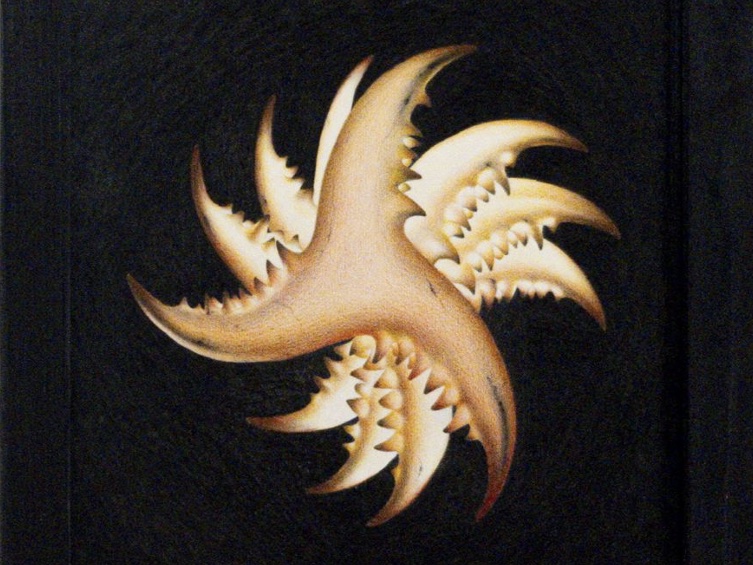
Miriam Salado
Carbunclo
Exhibition
-> Jun 20 2024 – Aug 17 2024
Proyectos Monclova presents the exhibition Carbunclo by Miriam Salado.
In some parts of the Spanish-speaking world, the word carbunclo is another name for rubies, while in others it can refer to Pyrophorus spp., a bioluminescent genus of click beetles that glows in the dark. But there is also a story from Sonora that speaks of a winged, birdlike being with shining eyes that flies nocturnally over the desolate paths and expanses of different parts of the state. People traveling on highways have even confused the headlights of big rigs with this creature, only to get lost in the rugged terrain en route to the mountains of the El Pinacate Biosphere Reserve.
Miriam Salgado has taken the idea of that incandescent light shining above a dense darkness as her starting point for elaborating a body of work that explores the creation of hybrid beings and objects with something sinister about them. For this fourth instalment of the exhibition cycle El dilema de unir los puntos (The Dilemma of Connecting the Dots), curated by Néstor Jiménez, the artist presents CARBUNCLO, an exhibition with precursors in both earlier projects and works in progress, including Armas salvajes (Wild Weapons) and Mutaciones bestiales (Beastly Mutations). The first of these consisted in making sculptures based on the natural defenses of the flora and fauna of the Sonoran Desert as well as man-made weapons used both for hunting and in acts of violence in northern Mexico. With these two frames of reference, she generated hybrid pieces in which bullet casings grew spines or claws. In the second series of works, Salado is currently exploring the materiality of weapons, flora, and fauna with the aim of transforming them and producing new weapons of defense, conceived for survival in the inhospitable environments caused by the climate change that humankind and extreme violence have created.
Miriam Salado’s work is marked primarily by her explorations of drawing and sculpture, but she also ventures into installation and video. Some of the artist’s lines of inquiry are the territory, flora, and fauna of northern Mexico, and how they are affected by human activity. Also worthy of note are her close attention to the cultural practices and local knowledge of the indigenous peoples who live in Sonora. For example, she is interested in delving into the transformations of the objects and attire used in traditional dances. This is apparent in such pieces as 540 Detonaciones (540 Detonations), in which the artist notes that the cowhide waistbelts worn in the Danza de los Fariseos (Dance of the Pharisees) feature AK-47 or R-15 casings. This practice began in the 1980s when the region’s craft makers started gathering these materials on the mountainsides. Some of these projects arising out of this focus indicate an early interest on the artist’s part in exploring the properties of industrial materials and natural resources, not only as mere physical media or objects, but also as subjects that embody changes in the cultural practices and local knowledge of the region, which are in turn consequences of the broader social and territorial transformations affecting Sonora.
In CARBUNCLO, the artist’s point is not to give a countenance or appearance to this legendary Sonoran creature, but rather to extract the formal effects of a very bright light like that of burning charcoal or of melting metals: something luminous that stands out against the darkness. The pieces Carbunclo I, II, and III present three large-format drawings in color pencil on paper, in which crisp, organic forms stand out quite forcefully. Another smaller drawing features a beastly mutation of something that recalls a cross between a jawbone and a ninja throwing star.
According to the artist, the sculptures in bronze and leather allude to remains of animals that had been transformed and mutated in an exaggerated way. For example, the artist invites us to imagine deer antlers that, upon being molted, have been used to make a bladed weapon. Other examples are Columna (Column), which traverses the exhibition and whose “vertebrae” are nailed to a base, Cuernos (Horns), and Aguijón (Stinger), which are now new instruments created for defense and survival in scenes of extreme violence. These works are also a strategy for reinventing nature, one that highlights its relationship to the social environment and exploits its hybrid character.
A hybrid creature, or the idea of something monstrous and different, challenges that which is regarded as the norm. Nevertheless, Miriam Salado’s work underscores that what is “accepted” has been mutating for decades: the transformation of the landscape as a result of the over-exploitation of natural resources, industrial contamination, climate change, extreme violence, and drug trafficking. These phenomena keep us in a constant state of alert, which in turn leads us to think that indeed we do need another type of defense to help us survive in these new inhospitable environments. But these hybrid objects do not light the way for us.
— Adriana Melchor Betancourt